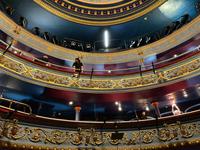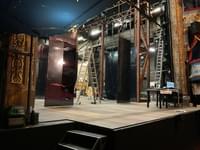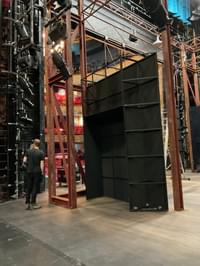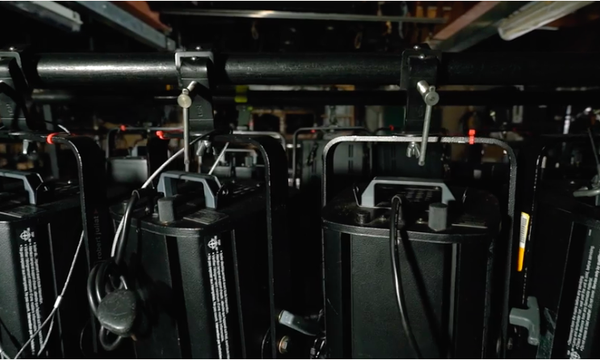News Story
The stage is being transformed into the world of Macbeth (an undoing) and it’s all systems go. The theatre is now entering a busy couple weeks leading up to various Previews and Press night. It is full of setting up lighting, set and sound before the actors even get onto the stage for tech rehearsals. Being a producing house, we don’t just open our doors where a set is placed onto stage and off we go, we design and build a set at Roseburn and then it is built again on the stage using the model box for reference.
I sat down with Euan McLaren our Technical Manager, to talk about all things get in, fit up, focusing and plotting.

Talk me through the process of getting a new show onto our main stage
The Macbeth (an undoing) set has been built at Roseburn (our workshop), so we need to transport it to the main stage. For this, we use a shipping company called ‘The Gilmours’ who specialize in a lot of theatre moving. The Macbeth set filled one big truck so that arrived at the theatre on the weekend, however, we had the previous An Edinburgh Christmas Carol set to take away, so we had to unload one set and load another to go back to Roseburn to be stored and used again. All the set is put onto the stage via the lift at the back and laid out in sections as to where it is going.
The first thing that happens on the stage is that the lighting gets rigged. The reason for that is because they are above the set so when the set is in you can’t lower the lighting bars. Obviously, there may be times we have to get to the lighting to change bulbs etc. – so we have had to create drift bars (shorter bars hanging off the bigger bars which allow the lights to come down in the middle of the set).
Once the lighting is up, we start building the set. We have a big team to do this which is made up of the stage team, lighting, and sound teams. For this project we also have two carpenters (chippies) who build the set and come to oversee it going up as they know how it goes together better than anyone. The first thing that is constructed is the floor. If the designer is opting to have something other than the stage floor – in Macbeth’s case it is a wooden floor (this can often be done before anything starts).
Are all sets built the same?
No. Sometimes they are free standing but other times it can be attached to bars which is how this set is built but set can also be built with flats which are normally free standing which were used in An Edinburgh Christmas Carol show.
For Macbeth (an undoing), there are two types of fixtures; upstage and downstage trucks (self-supporting units that can be moved on wheels) which move all around the stage and can be joined together and moved apart as needed and there are also sliders (attached to a rail at the top, so they are fixed in place) which slide back and forward across the front of the stage.

What’s unique about the way this set works & moves?
There is a lot to this set, normally it’s just a case of pushing things on and off and lowering backdrops. However, in Macbeth (an undoing)’s set there is more to it than that; things move in unison in and out and across the stage into a lot of different positions. This will have to be choreographed during tech week to make sure that we really get it slick.
When the trucks are in position, we have pre-drilled holes so that when the set is in position the bolts are dropped and the set can’t move – it also means it is in the same place every time and we aren't guessing where it goes. Particularly with set pieces this size and ones that link together like these do, you can’t be guessing what position it is in, especially in the dark when most scene changes happen.
To help with moving set down the stage too we have put little grooves into the stage to help guide the set in a straight line as it is moved by the stage crew. Also remember we are on a raked stage, so movement is always harder as gravity is against you.
Any stage magic in the show?
The blood/water tap on stage is an interesting part of the stage that we had to create and piece together. The pipe for the water goes up the set, across the side, out the back of the stage through two doors and into a water source. We have to do all the infrastructure when working in a black box stage – if you want plumbing you have to build the plumbing in. The blood comes from a big plastic box above the stage so that gravity can pull it down and give it enough force to come out of the tap as more than a drip. Water provides its own pressure; thick stage blood needs a helping hand, so you have got to make sure it’s up high.
You also need to consider the time it takes to switch between water and blood and how that mechanism works when you can see everything at the sides of the stage so someone can’t be sat there waiting to change the hose.
So, the set is built...what next?
The teams then focus on setting up the lights, hanging them, checking bulbs, colours and filters. They need to make sure they are all facing the right way (focus and plotting) using the lighting chart designed by the lighting designer for both on stage and front of house lighting ,and then we welcome the actors and director to the theatre.
Thanks Euan!
Who else can’t wait to see the set, in action? When you are sat watching Macbeth (an undoing) make sure you think about the team behind the scenes moving the set and making the magic happen to bring the world to life.



